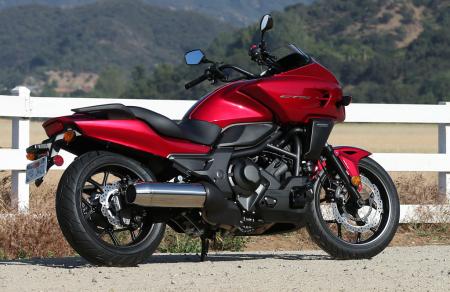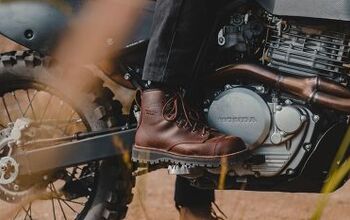2014 Honda CTX700/N Review - Motorcycle.com
Comfort. Technology. Experience. In the 21st century it’s these three pillars of motorcycling on which Honda intends to grow its brand. And thanks to the new Honda CTX700N and its faired CTX700 sibling, motorcycling – not just the other three marques in the Big Four but the industry as a whole – has been served notice: The future has arrived.
Introducing the Honda CTX700 and CTX700N. As we revealed back in February, Honda’s two brand-new motorcycles are aimed to appeal to newer, shorter – and younger – riders. Honda is confident the incorporation of its automatic Dual Clutch Transmission (DCT) and antilock brakes (ABS) along with a manageable 28.3-inch seat height, exceptionally nimble handling and practical performance will appeal to anyone intrigued by motorcycling – and perhaps their parents as well.
COMMUNITY: Check out the CTX700 Forum
With its laid back rider position providing the “comfort” and the DCT and ABS pitching in the “technology,” Honda is betting the total motorcycling “experience” will be readily available to everyone with the CTX – particularly those titillated by the idea of riding but leery of clutches and intimidated by mass.
The CTX succeeds – on every level. Honda has brought to market a low-dollar, strong yet manageable motorcycle that hits its bull’s-eye dead center. Lightweight, incredibly maneuverable and plenty powerful, the two new CTX 700cc “urban roadsters” are the ideal entry-level motorcycle. This, folks, is a game-changer.
VIEW: Read our 2013 Middleweight Multi-Tool Shootout
The CTX700N (base MSRP $6999) and CTX700 ($7999) feature 670cc parallel-Twin engines first introduced on the NC700 series, and they share the same frame as well. The “N” here stands, presumably, for Naked, as the non-N CTX700 adds an upper fairing for rider comfort and touring/commuting practicality. Both of those MSRPs represent standard models with manual transmissions, but for $1000 more you can get Honda’s second-generation Dual-Clutch Transmission and antilock brakes. You can’t get one without the other, but at a thousand bucks, the future is a bargain.
Put another way, the T is literally and figuratively central to the CTX concept, so Honda’s worry-free transmission technology is the key reason to buy one of these bikes. Sure, ABS is great, but it’s a throw-in compared to the revolutionary transmission and the riding experience it delivers. Whether the rider sets it and forgets it or uses the paddle shifter to optimize the bike’s gears and engine power, the Honda’s DCT works flawlessly. And while it’s designed primarily for new riders wary of clutching and shifting, traditionalists needn’t worry; it’s so simple even experienced riders can master it within a matter of miles.
Introduced on the sporty VFR1200, the second-generation DCT has been fine-tuned and dialed in to achieve shifting perfection. Occasional clunky transferals and unpredictable gear changes are gone, replaced by smooth functionality and crisp actuation. In Automatic mode, both up- and downshifts occur at precisely the right points, whether set at Drive or Sport, providing worry-free clutch-less shifting. Tickle the paddle shifters with your thumb and forefinger on the left grip and the CTX changes gears seamlessly, providing extra power or engine braking when desired.
Kudos to Honda for pushing the DCT envelope. “We’re fully committed to this,” asserts Assistant Press Manager Jon Seidel. But rather than rest on its laurels and shoehorn the groundbreaking transmission into existing motorcycles, Big Red decided to embrace the technology’s potential, building around it an entry-level bike designed and destined to rock the world of motorcycling.
Believe me, I realize the potential for hyperbole in that phrase, but I want to ensure this point gets across: the CTX700/N combines this innovative clutch-free technology with a universally accessible seat height, incredibly low center of gravity and strong motor. It’s possibly the finest handling, easiest-riding motorcycle I’ve ever thrown a leg over, which is especially impressive considering the CTX’s curb weights start at 478 pounds.
VIEW: Honda CTX700/N Revealed
It’s surely the best slow-speed maneuvering bike I’ve ever ridden, and on the road it never once failed to perform. All day long the CTX was put to the test, and on every single occasion it stood up to the task at hand. Even the most jaded moto-journalist couldn’t refrain from gushing about the accomplishment Honda had achieved with these bikes.
Both CTXs straddle the line between Standard and Cruiser without appearing schizophrenic; it’s a strange and different look, yet somehow it works. With angular headlights and broad shoulders, they resemble a street standard, punctuated by short, tight front fenders and long, pointed rear fenders. But the round brushed exhaust canister is side-mounted low, a clear cruiser-esque touch, and forward foot controls and the upright rider position are also obviously cruiser-inspired.
But Honda didn’t look to a throwback, classic V-Twin cruiser for that inspiration. In the spirit of creating something totally new, they wanted the CTXs to be fresh, innovative motorcycles, and thanks to that modern mindset the overall visual effect is rather akin to a slim-cut, three-piece suit: classic yet contemporary, stylish but not overly bold.
And appearance and performance were as central to the concept as the cutting-edge technology. When they’re ready to trade up, entry-level riders who start out on a CTX could easily decide they want to go in a sporty direction or the laid-back cruiser route, because the CTX has primed them with a riding experience that provides the best of both worlds.
The N is available in red or black, although you should opt for the black, because that means you got the DCT/ABS version. The CTX700 comes in white, but the DCT/ABS version will only be available in red.
VIEW: Honda CTX/N First Look
Suspension is provided by a 41mm fork offering 4.2 inches of travel and the rear suspension provides 4.3 inches of travel. The braking system is comprised of a two-piston caliper gripping a 320mm single disc up front and a single-piston job biting a 240mm disc in the rear. On the road, both CTXs displayed great all-around suspension on various terrain, and the brakes worked flawlessly with the DCT to provide a real two-wheel rush in the twisties.
How’s the power? We dyno tested the NC700X in our recent Middleweight Multi-tool Shootout and measured a peak power output of 47.7 hp at 6400 rpm, and 42.6 ft-lb. of torque at 4700 rpm. Honda says we should expect similar, if slightly lower, numbers from the CTX models. Regardless of what the charts say, I’m here to testify that both bikes have plenty of grunt for whatever an entry-level rider will ask of them
The CTX700N will be in dealerships by June; the faired version will arrive shortly thereafter. And thanks to enthusiastic European reception, Honda’s not waiting to see if the concept is embraced in North America and worldwide. In the coming months the international powersports market can expect to see DCT technology utilized across the entire spectrum of Honda’s on-road product line. As for motorcycle enthusiasts, can we expect to see more CTX bikes? Count on it. "These new models are just the first in a whole new family of CTX products of various displacements and engine configurations that will be rolled out in the future," Powersports Press Manager Bill Savino said in February when the CTX was first announced.
We’re excited to find out more about Honda’s vision of the future of motorcycling. If the rest of the new CTX Hondas are as technologically marvelous and as fun and easy to ride as the CTX700/N, it won’t be long before clutch levers are viewed the way kickstarters are now – as quaint curios of a bygone era.
More by Jon Langston



































Comments
Join the conversation